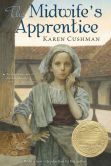http://img2.imagesbn.com/p/9780547722177_p0_v1_s114x166.JPG
 http://www.karencushman.com/images/books/bk_midw_hc.jpg
http://www.karencushman.com/images/books/bk_midw_hc.jpgCushman, Karen. 1995. The Midwife's Apprentice. New York: Clarion Books. ISBN: 0-395-69229-6.
The Midwife's Apprentice is the story of girl in medieval England who has no family, no home, no name, and no future. Her fortune changes when she meets Jane the Midwife, although Jane is a harsh mistress. After facing hardship and overcoming several obstacles, the girl who names herself Alyce, finally finds her place in the world.
Karen Cushman captures the drudgery, filth and hardship of medieval life from the opening chapter of The Midwife's Apprentice to the last page. She also shows the reader the transformation of a homeless, nameless, and hopeless girl into a young woman who finds everything she wants including, "A full belly, a contented heart, and a place in this world." The girl who names herself Alyce is familiar because she is the target of bullies and she is unsure of her future just as most young people are when attempting to get through middle and high school. Her challenges are faced in a time long ago, but the universal themes of loneliness, fear, and confusion will resonate with readers of today.
Alyce becomes Jane the Midwife's apprentice which saves her from sleeping in a dung heap, but subjugates her to Jane's harsh criticism. With time, Alyce uses her wits and survival skills to learn the secrets of midwifery until the day comes when a woman in labor asks Alyce to attend the delivery and Alyce fails. Readers will understand Alyce's despair and relate to her solution to run away from the village rather than face Jane's sharp tongue. Alyce's only friend, a cat she saved from the mean-spirited boys of the village remains by her side and they find a home at an inn by, "...trading her labor for bread and a bed..." Working at the inn allows Alyce to find herself through hard work and the help of someone she discovers is a friend when he tells her, "You got guts and common sense. Just because you don't know everything don't mean you know nothing." One success is all it takes for Alyce to realize that she does want to be a midwife after all and so she returns to the village and is stunned to discover that Jane will not take her back until she proves that she is willing to "...try and risk and fail and try again and not give up." Words of wisdom for every person trying to find their place in the world.
Cushman offers a concluding note that gives a brief history of midwifery including the renewed interest in the practice beginning in the 1960's. The discussion of herbs used by midwives and their influence on current medicines is especially interesting and encourages further reading.
The Midwife's Apprentice won several awards:
1996 Newbery Medal
1996 ALA Best Book for Young Adults
1996 ALA Notable Children's Book
1996 NCTE Notable Children's Book in the Language Arts
1996 Horn Book Fanfare Honor List
1995 List of Recommended Book (NY Public Library)
1995 Booklist Books for Youth Editor's Choice
1995 American Booksellers Association Pick of the Lists
1995 School Library Journal Best Books of the Year
Karen Cushman writes historical fiction that often features feisty female characters. Her 1994 book Catherine, Called Birdy was a Newbery Honor book. For more information about Karen Cushman, please visit her website http://www.karencushman.com/.
In a starred review Booklist said, "This novel is about a strong, young woman in medieval England who finds her own way home. . . . Kids will be caught up in this short, fast-paced narrative about a hero who discovers that she’s not ugly or stupid or alone." School Library Journal, also giving a starred review, stated, "With simplicity, wit, and humor, Cushman presents another tale of medieval England... Earthy humor, the foibles of humans both high and low, and a fascinating mix of superstition and genuinely helpful herbal remedies attached to childbirth make this a truly delightful introduction to a world seldom seen in children's literature." Publishers Weekly said that, "Cushman has an almost unrivaled ability to build atmosphere, and her evocation of a medieval village, if not scholarly in its authenticity, is supremely colorful and pungent."
A comparison of educational and occupational opportunities between the two time periods, as well as an exploration of the great differences of life for young people would be interesting for today's tweens and teens. Research into midwifery and modern childbirth practices is also an important and fascinating discussion point for teens considering parenthood in the future. I have suggested this title as a "quick read" for the "Adults Who Read YA Book Club" at my library. I think they would enjoy the look at midwifery as well. An excellent discussion guide can be found here: http://www.karencushman.com/pdfs/DG_midwife.pdf.
Amazon. Editorial reviews. http://www.amazon.com/The-Midwifes-Apprentice-Karen-Cushman/dp/0547722176/ref=sr_1_1?ie=UTF8&qid=1383703679&sr=8-1&keywords=midwife%27s+apprentice. (Accessed November 4, 2013.)
Barnes and Noble. Editorial reviews. http://www.barnesandnoble.com/w/midwifes-apprentice-karen-cushman/1100303592?ean=9780547722177. (Accessed November 4, 2013.)
Children's Literature Network. Awards.
http://www.childrensliteraturenetwork.org/aifolder/aipages/ai_c/cushman.php. (Accessed November 5, 2013.)
A comparison of educational and occupational opportunities between the two time periods, as well as an exploration of the great differences of life for young people would be interesting for today's tweens and teens. Research into midwifery and modern childbirth practices is also an important and fascinating discussion point for teens considering parenthood in the future. I have suggested this title as a "quick read" for the "Adults Who Read YA Book Club" at my library. I think they would enjoy the look at midwifery as well. An excellent discussion guide can be found here: http://www.karencushman.com/pdfs/DG_midwife.pdf.
Amazon. Editorial reviews. http://www.amazon.com/The-Midwifes-Apprentice-Karen-Cushman/dp/0547722176/ref=sr_1_1?ie=UTF8&qid=1383703679&sr=8-1&keywords=midwife%27s+apprentice. (Accessed November 4, 2013.)
Barnes and Noble. Editorial reviews. http://www.barnesandnoble.com/w/midwifes-apprentice-karen-cushman/1100303592?ean=9780547722177. (Accessed November 4, 2013.)
http://www.childrensliteraturenetwork.org/aifolder/aipages/ai_c/cushman.php. (Accessed November 5, 2013.)




